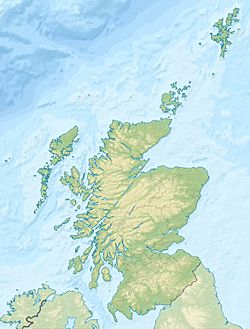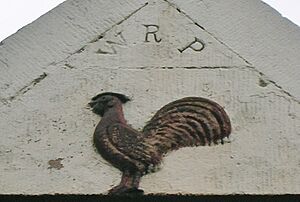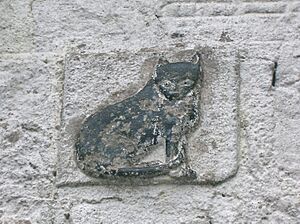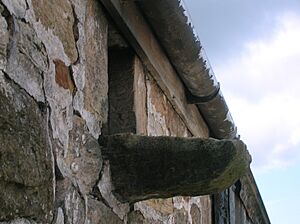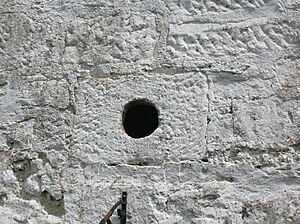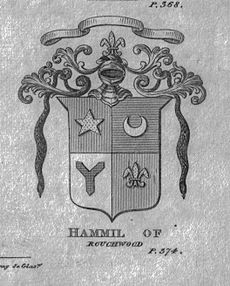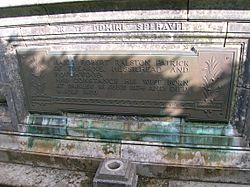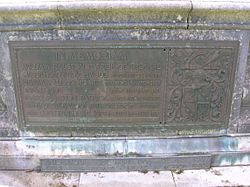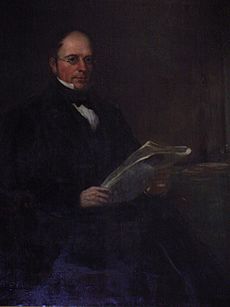The Lands of Roughwood facts for kids
Quick facts for kids Roughwood |
|
|---|---|
| Beith, North Ayrshire, Scotland UK |
|
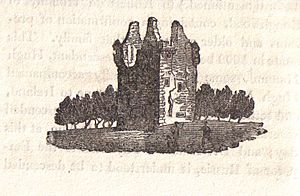
Roughwood Tower
|
|
| Coordinates | 55°44′07″N 4°38′11″W / 55.735414°N 4.636377°W |
| Type | Tower |
| Site information | |
| Owner | Private |
| Open to the public |
No |
| Condition | Removed, the farm buildings remain. |
| Site history | |
| Built | 15th century |
| In use | Until 17th century |
| Materials | Stone |
Roughwood, also known as Ruchwood, is a farm located near Beith in North Ayrshire, Scotland. It was once a large estate that included a small tower castle. The lands of Roughwood were part of the old Lordship of Giffen.
Contents
The Story of Roughwood
The name 'Ruch' comes from an old Scottish word. It means ground that is "difficult to travel through." This could be because it was rough, uneven, or covered with bumpy plants.
The Roughwood lands were quite large, about 160 acres in Beith and 85 acres in Dalry. For many years, these lands were in poor condition. They had no good roads, the farmhouses were falling apart, and there were few fences. This changed when the Patrick family bought the land.
Old Barony Courts
Long ago, special courts called Baron Courts were held at Roughwood. These courts were run by the Hammill family or their helpers, called baillies. For example, a court was held here on June 25, 1724. William Ralston acted as the baillie for Hugh Hammill.
Later, in 1740, the Hammills sold the lands and court rights to the Shedden family. By 1836, the Earl of Eglinton stopped appointing Baron Baillies. This meant the Baron Court at Roughwood no longer operated.
The Old Tower House
The castle at Roughwood was a simple, strong tower, known as a fortified keep. These towers usually had an entrance on the ground floor. Inside, a spiral staircase led up to the main hall on the first floor. The ground floor often had cellars for storage.
The main hall on the first floor was a large room. It usually had a big fireplace and window seats. This type of tower was common, and the picture of Roughwood's tower looks very similar to other tower castles like Busbie Castle.
The old tower house had a special stone carving on its front. This carving showed the coat of arms of the Hammill family. It had symbols like a star, a crescent moon, a special fork shape (like the Cuninghame family), and a fleur-de-lis (a lily flower). Above the shield was a fleur-de-lis as a crest.
Over time, half of the old tower was removed to make space for new farm buildings. But in the part that remained, an old doorway with fancy carvings was kept. The coat of arms might be the same one that was inside the tower, above a small fireplace on an upper floor. These carvings were very old and worn.
Life on the Farm
When Mr. Patrick bought Roughwood, he made many improvements. He built a new road through his lands. He also rebuilt the farmhouses and added fences for the fields. He planted many trees, and some of these plantations are still there today.
An old road called the Spiersland Way runs through the area. It used to connect different places. Now, it is mostly used by farm vehicles.
The farm may have once been involved in processing flax. Flax is a plant used to make linen fabric. There might have been a special pond for retting (soaking flax) nearby. A room in Roughwood Farm has a very unusual floor. It slopes down to a central area. This might have been a heckling shed. Here, flax fibers were separated. The leftover material, called 'tow', was collected. It could be used for stuffing pillows or removed because it caught fire easily.
Old Maps of Roughwood
Old maps help us see how Roughwood has changed over time.
- Blaeu's 1654 map, based on a map from the early 1600s, shows 'Ruchwood' as a home, not a fort.
- Roy's map from 1747 shows the Roughwood settlement.
- Armstrong's 1775 map marks 'Raewood' near a large area of moorland or bog.
- Thomson's map from 1832 shows Roughwood near a crossroads.
- The 1856 map shows a limestone quarry and kilns near Roughwood.
- The 1895 map shows what might be a horse gin, a machine used for power, outside one of the farm buildings.
Special Carvings and Features
The older northern part of the farm has some unusual stone carvings. One carving shows a fox or a cat. Another carving shows a bird, which is a falcon. The falcon is the family crest of the Ralston family. You can see this falcon on their memorial in Beith Cemetery. The reason for a cockerel (rooster) carving is not known. In old symbols, a cockerel often stood for courage and never giving up.
Roughwood also has two special holes built into its farm buildings, called owl holes. There are even remains of a third one. One owl hole is a normal shape, but the other is triangular. These holes were made so barn owls could get into the buildings. Farmers liked this because the owls would hunt rats and mice on the farm. Owl holes usually have an entrance and a platform for the owl to land on.
One stone used for ventilation looks like a "blind gun loop." These were openings in old fortified buildings that allowed defenders to fire guns from inside. However, the view through this type of loop was very limited. Some of the stones on the farm suggest they were prepared for a rough outer coating, like what was used on old tower castles.
Families Connected to Roughwood
The Hammil Family
The Hammil family owned Roughwood for many generations. A man named Walter de Hamule held lands in Scotland a long time ago. The Roughwood estate seems to have become separate from the Giffin estate before 1371. The lands of Roughwood and Broadstone were given to Robert de Hommyl in 1452. This was payment for attending three important yearly courts.
The Hammil family kept these lands through their sons for eight generations. In 1600, Hugh Hammil owned Roughwood. His son, Matthew, later sold the estate to Robert Shedden around 1736. Matthew died without marrying. His sister, Anna, married Robert Montgomery from a nearby house.
The Hammil family's coat of arms, carved on the house, showed different symbols. These included a gold star, a silver crescent moon, and a gold fleur-de-lis. The crest was also a fleur-de-lis. Their supporters (figures on either side of the shield) were two serpents.
Some records say that Hugh Hammill himself sold the lands to Robert Shedden in 1713. The Sheddens were merchants in Beith. In 1720, Catherine Peebles, Matthew Hammill's widow, tried to keep her right to live at Mains of Roughwood.
The Ulster Connection
Some members of the Hugh Hammil family from Roughwood went to Ireland. They settled there as merchants in the Dublin area. This happened when Hugh Montgomerie brought Scottish settlers to Ireland in the 1600s. These settlers, known as Ulster-Scots, helped introduce linen weaving to areas like Lurgan in Ireland. In 1636, Hugh Hamill of Roughwood even attended a funeral in Ireland as an important guest.
Most of the Hamill family members settled in Antrim, Ireland. Many Hamills in North Antrim today are descended from Hugh Hamill of Roughwood.
The Farm and Its Surroundings
The Shedden Family
Robert Shedden (born 1643) was a merchant in Beith. He had two sons, Robert and John. Robert, the older son, inherited the lands of Millburn and later Roughwood. He bought Roughwood from the Hammil family in 1713.
His son, John Shedden (born 1690), took over Roughwood and Millburn. He also owned other properties in Beith. John's son, William Ralstoun Shedden, inherited the estates in 1770. He lost property in Virginia because of American independence. He then moved to Bermuda and later to New York, never returning to Roughwood.
After William's death, his nephew, Robert Patrick, paid for the estate to avoid it being sold off. Robert later sold Roughwood and Millburn to his younger brother, William Patrick. This way, William acquired his mother's family estate.
The Shedden family had their own coat of arms. It featured griffins' heads, crosses, a shell, and cinquefoils (five-leaf shapes). Their crest was a lion, and their motto was "Virtute et Fidelitate," meaning "By Valour and Fidelity."
A Family Dispute
A later William Ralston Shedden (born 1828) became convinced he was the rightful owner of the Roughwood estates. He spent all his money on legal battles to prove his claim. Even after he ran out of money, his sister, Annabella Jane Shedden, continued the fight. She took the case to the House of Lords, but it was a long and unsuccessful effort.
The Patricks and Ralston-Patricks
In 1823, William Patrick owned the lands of Roughwood. He also bought other nearby properties. By the 1870s, these properties were part of the Roughwood estates, owned by William Ralston-Patrick.
A portrait of William Patrick used to hang in the Beith Town House. He was known for making many improvements in the area. People often asked him for his advice on local matters.
The Ralston-Patrick family has a memorial in Beith cemetery. It lists several family members, including William Ralston-Patrick and his wife, Jemima Alison. It also mentions their children and grandchildren. One notable family member was Major Lisle Ryder, who died in World War II.
The Ralston family crest is a falcon. Their motto is "Fide et Marte," meaning "Faithful and Warlike." The Patrick family motto is "Ora et Labora," which means "Pray and Labor." Their crest is a clenched hand holding a Saint Andrew's cross.
Quarrying and Lime Kilns
The land around Roughwood has a lot of limestone. Because of this, there were many limestone quarries in the area. Lime kilns were used to burn limestone to make lime. This lime was then used to improve the soil for farming.
Roughwood had at least two lime kilns nearby and a large limestone quarry. The quarry is now filled in, and the lime kilns have been taken down. These kilns would have created a lot of pollution in the area, even though they were quite close to Roughwood Farm.
Burnside Cottage
Burnside is a property located near Roughwood Bridge, across the Powgree Burn. The Parker family lived here. A child named John Parker was born at Burnside in 1898.
The garden area at Burnside suggests there might have been a mill pond here once. However, there is no longer any sign of a mill.
Interesting Facts
- In 1855, William Patrick of Roughwood is said to have hired a builder to construct the 'Barnweil Monument' near Ayr. This monument honors William Wallace.
- Dr. Hammil, who was a private doctor to the Emperor of Russia, is believed to have come from the Roughwood branch of the Hammil family.
- The Parker family lived at Roughwood for 100 years, starting in 1795. They later moved to Kirkcudbrightshire, where they still farm today.
- An old map from the early 1600s shows a place called 'Bar-Kyipe'. This area became part of the Roughwood estate in 1874.
- A painting of William Ralston-Patrick used to hang in the Beith Townhouse. It is now in Beith Library.


